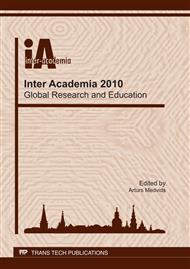[1]
Gettering and Defect Engineering in Semiconductor Technology XIII, Edited by: M. Kittler and H. Richter. Solid State Phenomena Vols. 156 – 158 (2009).
Google Scholar
[2]
F. Hartmann et al (RD50 Collaboration): Nuclear Instruments and Methods in Physics Research A Vol. 617 (2010), p.543.
Google Scholar
[3]
S. Karpinskas, A. Smilga, J. Vaitkus and J. Viščakas, in: Proc. Int. Conf. Physics and Chemistry of Semicond. Heterojunct. and layered structures, volume II, pp.355-362, Akademi Kiado, Budapest (1971).
Google Scholar
[4]
A. Rose. Concepts in photoconductivity and allied problems. (Interscience Publishers, New York 1963).
Google Scholar
[5]
J. Viščakas and J. Vaitkus. Lithuanian physics collection Vol. 5 (1965), p.123.
Google Scholar
[6]
J. Viščakas, J. Vaitkus, A. Matulionis and A. Smilga, in: Digests of All-Union Workshop on II-VI semiconductors and their application, pp.104-105 Kiev, (1966).
Google Scholar
[7]
J. Vaitkus, R. Jasinskaite, V. Kazlauskienė, J. Miškinis and A. Zindulis: Thin Solid Films, Vol 387/1-2 (2001), p.212.
Google Scholar
[8]
J. Vaitkus, R. Tomašiūnas, J. Kutra, M. Petrauskas and A. Zindulis: J. Cryst. Growth, Vol. 101 (1990), p.826.
Google Scholar
[9]
J. Vaitkus, V. Kazlauskiene, J. Miskinis and J. Sinius: Materials Res. Bull.: Vol. 33 (1998), p.711.
Google Scholar
[10]
J. Vaitkus, R. Baubinas, V. Kazlauskienė, J. Miškinis, A. Mažeikis, E. Žąsinas and A. Žindulis: Microelectr.J. Vol. 30(4-5) (1999), p.335.
Google Scholar
[11]
W.C. Omara, R.B. Herring and L.P. Hunt. Handbook of Semiconductor Silicon technology. Noyes Publ. (1990).
Google Scholar
[12]
V. Amstibovskij, J. Vaitkus, E. Gaubas, A. Kaniava and A. Rudaitis: Lithuanian physics collection Vol. 28(5) (1988), p.644.
Google Scholar
[13]
V. Amstibovskij, private communication.
Google Scholar
[14]
J.A. Grigorjev, V.I. Biberin, V.B. Osvenskij, S.P. Grisina, J.J. Vaitkus, J.J. Storasta, A.V. Markov and O.L. Egorova. USSR A.C. No. 242614, priority from 10. 10. 85 (1986).
Google Scholar
[15]
V. Kažukauskas, J. Storasta, and J. -V. Vaitkus: J. Appl. Phys. Vol. 89 (2001), p.557.
Google Scholar
[16]
M. Huhtinen: Nuclear Instruments and Methods in Physics Research A Vol. 491 (2002), p.194–215.
Google Scholar
[17]
E. Gaubas, T. Čeponis, A. Uleckas and J. Vaitkus: Nuclear Instruments and Methods in Physics Research A: Vol. 612(3) (2010), p.563.
DOI: 10.1016/j.nima.2009.08.024
Google Scholar
[18]
J.L. Hastings, S.K. Estreicher and P.A. Fedders: Phys. Rev. B Vol. 56(16) (1997), p.10215.
Google Scholar
[19]
G. Davies, S. Hayama, L. Murin, R. Krause-Rehberg, V. Bondarenko, A. Sengupta, C. DaVia, and A. Karpenko: Radiation damage in silicon exposed to high-energy protons. Physical Review B 73, 165-202 (2006).
DOI: 10.1103/physrevb.73.165202
Google Scholar
[20]
M. Moll et al. (RD50 Collaboration): Nuclear Instruments and Methods in Physics Research A Vol. 546 (2005), p.99.
Google Scholar
[21]
T. Čeponis, A. Balčytis, A. Dzimidavičius, E. Gaubas, J. Kusakovskij, and K. Žilinskas: Lith. J. Phys. Vol. 50(2) (2010), p.215.
DOI: 10.3952/lithjphys.50205
Google Scholar


